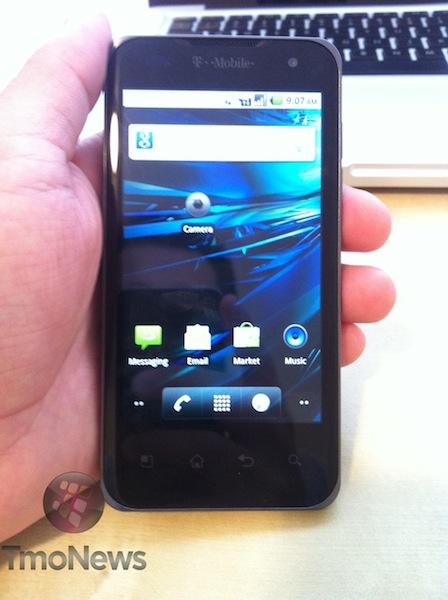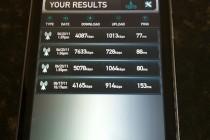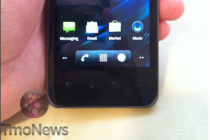TmoNews Reviews The T-Mobile G2x
When I finally got my hands on a T-Mobile G2x review unit from T-Mobile, my first thought was one of fear about how my time with the handset would go based on some of the current discussions surrounding the device. As it turns out, my experience didn’t suffer from many of the troubles that have plagued G2x users from the start. T-Mobile’s first dual-core phone expectations for the G2x were high and the phone doesn’t disappoint. The unfortunate part of my G2x review is that my thoughts and experiences were somewhat tainted out of concerns that the phone would freeze, reboot or suffer from some kind of malfunction. With none of that taking place, let’s dive right in.
Specifications:
- 4″ LCD screen
- Android 2.2.2
- 8 megapixel camera
- 1.3 megapixel front facing camera
- 4G HSPA+ 14.4Mbps capable
- 1 Ghz Nvidia Tegra 2 dual-core processor
- 1080p video recording
Pros:
- Fast 4G data speed
- Dual-core processor means fast
- 8 megapixel camera takes good photos
- Strong signal strength
- HDMI output
Cons:
- Reported to suffer from reboots and freezes
- Box shape design not always comfortable to hold
- LCD screen not up to par with alternative Android models
- No distinguishing features outside of dual-core processor
- Screen resolution could be higher
Hardware:
The G2x hardware is a mixed bag as far as my own personal usage, but from talking to readers the form factor is clearly personal preference. I’m a big fan of a rounded design as I feel that form fits a bit more to the contour of my hand so the box design of the G2x wasn’t my favorite. That being said, the build quality of the phone didn’t leave me concerned. I wouldn’t say it’s the sturdiest device around but I didn’t have any concerns it would fall apart in my hand.
There are only three tactile buttons on the device, the volume rockers (up and down) on the right-hand side of the device and the power button on top. The front of the device shows the standard Android layout of Menu, Power, Back and Search capacitive touch buttons. The top of the device next to the home button also belongs to the HDMI port for those moments when you just want to display something on the big screen TV.
buttons. The top of the device next to the home button also belongs to the HDMI port for those moments when you just want to display something on the big screen TV.
I feel compelled to throw this in as I simultaneously write the Sensation 4G review and say that in terms of hardware, form factor between the devices is absolutely personal choice. The two devices distinguish themselves quite well based on screen size and physical hardware shape so it’s definitely a try before you buy deal. At the end of the day, your choice will come down to as much size as it does Vanilla Android versus Sense 3.0.
The G2x screen isn’t going to win any awards but it’s certainly not going to torture you either. I wouldn’t begin to compare to Super AMOLED or Retina Display but it can hold its own. However, just fuggadaboutit in sunlight. We wouldn’t have any problem with a slightly higher resolution screen that might make better use of the G2x’s excellent media capabilities. The 4″ IPS display maintains an 800 x 480 resolution and it definitely works better on paper than it does in the real world. We don’t expect anyone to be disappointed with the display but, as we said, if you put the G2x up against a Super AMOLED or Retina Display, you’ll feel instantly jealous.
The matte soft-touch back feels great in the hand and the device definitely wouldn’t be considered heavy. The bottom of the device takes a design cue from the iPhone and places the charging port between the speaker and the microphone. Perhaps this was just on our own unit but light presses on the touchscreen didn’t seem to register, quickly leading us to believe the touchscreen is slightly less sensitive than other Android models.
The one place where the G2x truly shines is under the hood. This phone has plenty of horsepower. Nvidia’s 1GHz dual-core Tegra 2 processor partnered with 512MB of RAM and this phone comes ready to play. The G2x certainly feels fast and we didn’t experience any noticeable slowdowns when running multiple applications.
Software:
Vanilla Android fans will find a lot to love about the G2x with Android 2.2 Froyo paired with the dual-core processor as the G2x is blazing fast. Opening and closing applications happens without delay along with the overall feel of the device is just…fast. T-Mobile added in a few of its own applications but, by and large, this phone is bloatware free. No skin or UI customizations here and that’s exactly what some of you want. Others will prefer the extra customizations allowed by devices like the Sensation 4G and Sense 3.0.
added in a few of its own applications but, by and large, this phone is bloatware free. No skin or UI customizations here and that’s exactly what some of you want. Others will prefer the extra customizations allowed by devices like the Sensation 4G and Sense 3.0.
The G2x is running Android 2.2.2 and while T-Mobile has promised Gingerbread quite a few times, we’re still unsure exactly when that will happen at the time of this writing. In the meantime, the G2x’s plain vanilla Android comes stocked with Need for Speed Shift, a Gameloft Nova Demo, T-Mobile TV, TegraZone games, Qik Video Chat and Zinio reader. T-Mobile also includes both Swype as a keyboard option and the Wi-Fi calling app for piggybacking on a Wi-Fi connection for voice calls. The phone doesn’t feel cluttered and, while T-Mobile included some of their own apps such as their My Account and App Pack applications, there definitely is nothing here that makes you feel like the phone is inundated with bloatware. This phone will be an easy transition for owners of previously stock Android devices such as either the Nexus/Nexus S or the T-Mobile G2.
So we know the hardware performs well with the Tegra 2 dual-core processor but how about its impact on software? The G2x feels snappy and, just like our comments on the hardware, the phone runs without any noticeable slowdowns. On a day-to-day performance aspect, you’d be hard pressed to notice any differences between a single-core and dual-core processors until you start launching multiple apps, games or playing around with benchmarking apps. That being said, the opening of applications is still noticeably faster on the G2x especially when you already have an application running in the background.
The G2x really showed its power on the Quadrant tests with scores that were averaging right around the 2400 range, easily besting the Nexus S and DROID X by over a 1000 points. Even the Sensation 4G came in a little lower at around 1900. One thing is for certain. When the G2x finally receive its Gingerbread update, this phone should fly.
points. Even the Sensation 4G came in a little lower at around 1900. One thing is for certain. When the G2x finally receive its Gingerbread update, this phone should fly.
Media and Camera:
The G2x shines when it comes to media playback especially with the Tegra 2 chipset allowing for HDMI mirroring on an HDTV. Everything you can see on the phone’s screen can be thrown up on your HDTV and you can enjoy the fun with the whole family. The G2x comes with 5.4 GBs of memory along with a Micro-SD slot under the back cover which perfectly accepted our 16GB card.
Videos on the phone played beautifully especially the perfectly rendered original Transformers movie included out of the box. 1080p was a little choppy, especially playing back on the computer. Scaling the video down to recording at 720p made the world a better place and they played back without a problem.
The G2x has an 8 megapixel camera and the images are ok, decent but not wonderful. As you can see in the sample photos, the colors look a little washed and while I’m by no means a professional photographer, I wasn’t terribly impressed by the quality of the images. Low-light pictures were grainy and disappointing as the phone tended to work up its ISO to avoid any blurring. The 1.3 megapixel camera on the front worked nicely although we only tried one Qik video chat call and it was just a few moments long. We’ll reserve judgment on the front facing camera until we can get our hands on Google video chat that comes with Gingerbread. You can see a bunch of shots we took inside and outside using the G2x in the gallery at the end of the post!
images. Low-light pictures were grainy and disappointing as the phone tended to work up its ISO to avoid any blurring. The 1.3 megapixel camera on the front worked nicely although we only tried one Qik video chat call and it was just a few moments long. We’ll reserve judgment on the front facing camera until we can get our hands on Google video chat that comes with Gingerbread. You can see a bunch of shots we took inside and outside using the G2x in the gallery at the end of the post!
Phone and Coverage:
One area that I had absolutely no problems with were phone calls and the G2x held a strong and constant 4G signal in the Palm Beach/Broward county areas of South Florida. The phone had plenty of volume in the earpiece which is always something I look for along with the speakerphone being quite loud as well.
Wi-Fi calling worked flawlessly as I expect from the folks at Kineto Wireless and, while I didn’t need the signal improvement, I still enjoy having a fall back option for bad coverage areas.
Conclusions:
My first impressions of the G2x at CES in January was a “wow” factor and that didn’t go away as I spent a little under two weeks with the phone. The Galaxy S 4G and Sensation 4G’s have better displays but you accept a tradeoff with both of those devices. With the G2x you’ll get a plain vanilla Android experience against Sense 3.0 on the Sensation and Touchwiz on the Galaxy S 4G. The Galaxy S 4G also brings faster HSPA+ speeds of 21Mbps against the G2x’s 14.4Mbps and that difference can be noticeable in the real world. The G2x is a great balance of quality hardware, speed, power and plain vanilla Android. If we could make one significant change to the G2x, it would be an increase to the screen resolution to give some ability to see the phone in direct sunlight, a necessary evil for us in South Florida.
The biggest problem with the G2x is the amount of hiccups that have been caused by a bad launch experience, with a large swath of users plagued by various software troubles. I tried to be completely objective during this review but it was hard knowing in the back of my head all the troubles I’ve been reading about from TmoNews readers.
Still, I truly enjoyed my time with the G2x as I didn’t experience one problem with the device and I would not hesitate to recommend it post-Gingerbread. As it stands now, the phone is a great product but the current problems make it hard to give it a stamp of approval. With that being said, the G2x has a lot going for it and as soon as the phone gets an update to solve all of the lingering problems, it’ll remain one of T-Mobile’s best offerings.
































